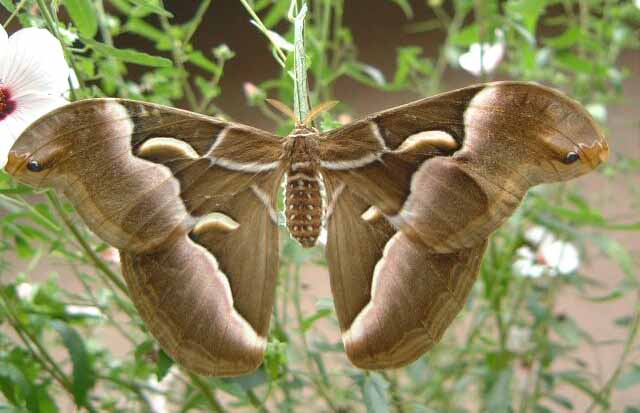Samia pryeri
Samia pryeri
(Butler, 1878)
(Attacus)

Samia
cynthia pryeri female, Fukazawa, Nagasaka, Ymanashi, Japan.
| TAXONOMY:
Superfamily: Bombycoidea, Latreille, 1802
Family: Saturniidae, Boisduval, [1837] 1834
Subfamily: Saturniinae, Boisduval, [1837] 1834
Tribe: Attacini, Blanchard, 1840
Genus: Samia, Hubner, 1819
| |
MIDI MUSIC
"Asian Spring Blossoms"
ON.OFF
<bgsound src="AsianSpringBlossoms.mid" LOOP=FOREVER>
|
DISTRIBUTION:
The Samia pryeri moth
(forewing length: males: 60-70mm; females: 65-78mm) flies in the
four main islands of Japan: Hokkaido, Honshu, Shikoko and Kyushu.
Records also exist for the Ryukyu Islands and Tsushima. There are
also reported populations in northeastern China (Heilongjiang).
The postmedian line bends significantly and is not
intersected by the crescents. The black eyespot near the forewing
apex is quite small. The rose area of the postmedial line, typical of so many species,
is replaced by a dull purplish gray. The male forewing is strongly
falcate.
The moth is named to honour Henry James Stover Pryor of Yokohama.
FLIGHT TIMES AND PREFERRED FOOD PLANTS:
The species appears to be bivoltine with peak flights in May-June and
August-September, with some of the early cocoons overwintering.
Larvae are probably polyphagous on native
trees, and Ailanthus altissima, Celtis sinensis,
Cinnamomum camphora, Clerodendrum tricotomum, Firmiana platanifolia,
Ilex rotunda, Ligustrum japonicum,
Osmanthus fragrans, Paulownia tomentosa,
Phellodendron amurense, Styrax japonica and
Zanthoxylum ailanthoides are confirmed hosts.
ECLOSION, SCENTING AND MATING:
The female begins scenting
after dark by projecting a scent gland from the posterior tip of her abdomen. Males fly into the breeze
and hone in on the pheromone plume via their highly developed and sensitive antennae.
EGGS, LARVAE, COCOONS AND PUPAE:
Eggs are deposited on host foliage with incubation
requiring eight to ten days.
Larval Food Plants
Listed below are primary food plant(s) and alternate food
plants listed in Peigler's and Naumann's
A Revision of the Silkmoth Genus Samia. It is hoped
that this alphabetical listing followed by the common name of the foodplant will
prove useful. The list is not exhaustive. Experimenting with closely
related foodplants is worthwhile.
Ailanthus altissima
Celtis sinensis
Cinnamomum camphora
Clerodendrum tricotomum
Firmiana platanifolia
Ilex rotunda
Ligustrum japonicum
Osmanthus fragrans
Paulownia tomentosa
Phellodendron amurense
Styrax japonica
Zanthoxylum ailanthoides.......
|
Ailanthus
Japanese Hackberry
Camphora
Clerodendrum tricotomum
Chinese parasoltree
Round Leaf Holly
Japanese Privet/Wax Leaf Privet
Tea olive
Empress tree/Princess tree
Amur corktree
Japanese snowbell
Japanese prickly ash
|
Use your browser "Back" button to return to the previous page.
Return to Samia genus
Goto Asian Pacific Saturniidae Directory.
Goto Main Saturniidae Index

